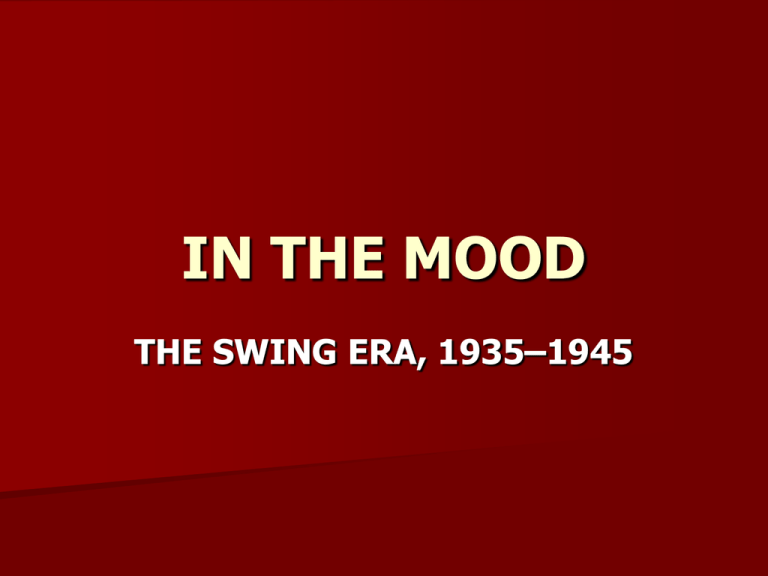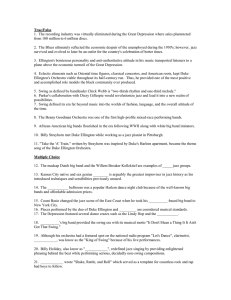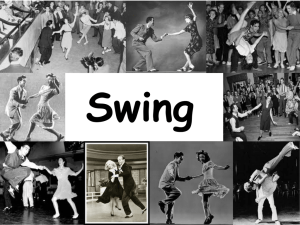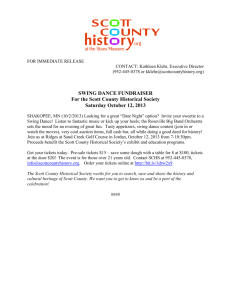4 swingera
advertisement

IN THE MOOD THE SWING ERA, 1935–1945 Swing Music and American Culture The swing era: 1935–1945 – Beginning in 1935, a new style of jazzinspired music called “swing” transformed American popular music. – Initially developed in the late 1920s by black dance bands in New York, Chicago, and Kansas City The word “swing” (like “jazz,” “blues,” and “rock ’n’ roll”) derives from African American English. Big Bands Between 1935 and 1945, hundreds of large dance orchestras directed by celebrity bandleaders dominated the national hit parade Many of the bands crisscrossed the country in buses, playing for dances and concerts at local dance halls, theaters, and colleges. Swing and the Music Business By the late 1930s, the record industry had begun to recover from the Great Depression and the rise of radio. Between 1935 and 1945, well over half of the records that sold more than a million copies were made by big dance bands. Swing music pulled the American music industry out of the Great Depression. Dance Styles The lindy hop Named in honor of Charles Lindbergh’s solo transatlantic flight (1927) – Differed from popular jazz dance styles of the early 1920s Whereas the older dances emphasized bouncy, up-anddown movements, the lindy was smoother, with more fluid horizontal movements. The lindy provided greater scope for improvisation, including the “breakaway,” a moment when dancers would part company and dance solo. Harlem New York’s Harlem had many famous nightclubs and dance halls: – The Savoy Ballroom – The Cotton Club – The Apollo Theater Originally populated by European immigrant groups By the late 1920s, Harlem was home to a substantial, well-educated, and relatively prosperous black middle class. The Cotton Club “Black and tan” nightclubs like the Cotton Club were generally owned and operated by Italian and Jewish mobsters. The Cotton Club’s audiences were predominantly white The most successful dance orchestras at the Cotton Club—led by Duke Ellington and Cab Calloway—provided musical accompaniment for stage acts featuring scantily clad “brown beauties,” men in ape costumes, and jungle scenery. Black and White in the Swing Era The swing era represented a step forward in cultural communication across racial boundaries. – Black people often attended concerts by white dance bands. – White people began to study and imitate black culture with greater passion and in greater numbers than ever before. Not a relationship of full equality – Only a handful of dance bands were racially integrated – Even the most popular of black dance bands faced serious economic and social disadvantages The Big Bands Brought a youthful energy back to American popular music. – Its core audience initially consisted of collegeage adults and teenagers. Swing was an exciting, brash, vital music, inspired by black aesthetics and consonant with the growing optimism of a nation emerging from a devastating economic depression. Features of Big-Band Swing Music Call-and-response – One of the signal features of swing music – Central to African American musical traditions – Beginning in the late 1920s, black dance band arrangers began to apply this principle to ensemble writing, treating the brass and reed instruments as separate sections and setting them off against one another. – This basic approach—in which “conversations” were set up between parts of a band—was later adopted by white bands. Features of Big Band Swing Music Rather than the “boom-chick” two-beat rhythms of syncopated dance band music of the 1920s, the rhythmic feeling of swing music is more continuous and flowing. – Bass plays on all four beats in a measure, rather than just the first and third beats, a technique called “walking” the bass. – The drummer adds to this effect by playing all four beats with the bass drum pedal (a technique called “four on the floor”) and playing a regular tapping pattern on the largest cymbal (a “ride” cymbal). Listening: “Wrappin’ It Up” Music and arrangement by Fletcher Henderson (1898–1952) – Recorded in 1934 in New York, performed by Fletcher Henderson and His Orchestra The Henderson band is considerably larger than most syncopated dance bands of the 1920s: – Five brass instruments (three trumpets and two trombones) – Four reed instruments (saxophones and clarinets) – Rhythm section consisting of piano, bass, drums, and guitar – Total of thirteen musicians Listening: “Wrappin’ It Up” Has all the characteristics of swing music: – A big, full, smooth ensemble texture – Lots of call-and-response patterns between the brass and reeds – A steady, flowing groove, with the bass, drums, and guitar playing on all four beats, while giving a slight push to the second and fourth beats. Listening: “Wrappin’ It Up” Thirty-two bar ABAC structure (two sixteen-measure halves) Intro—eight measures – Bars 1–4: brass and reeds play call-andresponse figures (each one measure long) – Bars 5–8: brass and reeds play shorter calland-response figures, then play together to lead into the main body of the arrangement Listening: “Wrappin’ It Up” Fletcher Henderson’s “Wrappin’ It Up” is a great example not only of the rhythmic flow and texture of swing music but also of the balance between simplicity and complexity that characterizes the best bigband arranging. The arrangement was later provided to Benny Goodman, who recorded it in 1938. Benny Goodman (1909–86) The “King of Swing” Born in Chicago, the son of working-class eastern European Jewish immigrants Made his first records under his own name in 1927 Freelance musician during the depression years Benny Goodman (1909–86) His career was boosted by John Hammond (1910–87) – Hammond, an influential jazz enthusiast and promoter, was an A&R (artists and repertoire) man with Columbia Records. Hammond arranged Goodman’s first recording dates with Columbia. He pushed the band in the direction of the more strongly jazz-influenced music played by most black dance bands. Hammond also helped Bessie Smith, Billie Holiday, Count Basie, and (much later) Aretha Franklin, Bob Dylan, and Bruce Springsteen secure recording contracts with Columbia Records. Benny Goodman (1909–86) In 1934, the Goodman Band appeared on the NBC Radio Show Let’s Dance. The Goodman Band embarked on a tour in summer 1935. – The tour did not begin successfully. – Audiences were not interested in the “hot” arrangements that the band wanted to play. – The tour bottomed out in Denver; audiences wanted their money back. – They were a huge success when they reached California and performed at the Palomar Ballroom. – West Coast audiences had heard the band on the Let’s Dance radio show. – This success signaled the birth of the swing era. Big Band Blues Count Basie, Duke Ellington, and Glenn Miller William “Count” Basie (1904–84) Basie’s band was the most closely associated with the blues tradition. Basie was born in New Jersey. His early experience was as a piano player and bandleader in Kansas City, Missouri. Kansas City In the 1920s, Kansas City was still a frontier town Had a famously crooked mayor (“Boss” Pendergast) – His administration encouraged a lively, and illegal, nightclub scene. Many of the greatest jazz musicians honed their improvisational skills in Kansas City at competitive allnight jam sessions. – Provided a chance for budding virtuosos to test their musical skills and endurance against one another During the 1920s and early 1930s, black dance bands in Kansas City had developed their own distinctive approach to playing hot dance music. Territory Bands – – – – – The Bennie Moten Orchestra and Andy Kirk’s Blue Devils toured the southwestern United States, developing a hard-swinging, powerful style with lots of room for improvised solos. Linked to the country blues tradition Relied heavily on riffs Few of the jazz musicians in Kansas City had the formal music education of East Coast musicians, and they often played with a looser, less precise feeling. Kansas City musicians relied heavily on “head charts,” arrangements that evolved during jam sessions and were written down only later. In rhythmic terms, the Kansas City bands tended to swing more intensely and with greater abandon than the East Coast dance bands. Boogie-Woogie One important influence on the rhythmic conception of the Kansas City bands was the boogie-woogie blues piano tradition. – – – Sprang up during the early twentieth century in the “southwest territory” states of Texas, Arkansas, Missouri, and Oklahoma and became a popular fad during the big-band era Developed in the environment of the barrelhouses Solo pianists developed a powerful style that could be heard over the crowd noise. John Hammond In 1936, John Hammond, who had recently helped start Benny Goodman’s career, heard Count Basie’s band on a late-night short-wave radio show in Chicago. Hammond was able to get Basie a recording contract with Decca, a new record company interested in capitalizing on the swing craze. Listening: “One O’Clock Jump” Written by count Basie and Harry James Performed by Count Basie and His Orchestra Recorded in 1937 by Decca – The Count Basie Orchestra’s theme song Excellent example of the Kansas City bands’ relaxed but energetic rhythmic approach – Emphasis on jazz improvisation – Reliance on informal and flexible head arrangements Listening: “One O’Clock Jump” Structure of the tune – Ten choruses of twelve-bar blues – The basic arranging technique involves heavy use of riffs and call-and-response patterns— divided between the brass and reeds. – A succession of improvised jazz solos – The closest thing to a melody does not appear until the next-to-last chorus. Listening: “One O’Clock Jump” The recording begins with an eight-bar piano boogiewoogie introduction and two improvised twelve-bar blues choruses by Basie. Then there is a key change, the band enters, and we hear a series of solos, on saxophone, trombone, saxophone again, and trumpet, each supported by background riffs. After these solos, Basie plays another chorus in his famous and elegant “two-fingered” style, and then the entire band comes in. The final three choruses of riffs are what identify “One O’Clock Jump” for swing fans and musicians alike. Edward Kennedy (Duke) Ellington (1899–1974) Widely regarded as one of the most important American musicians of the twentieth century Born in Washington, D.C., the son of a navy blueprint maker Came from a middle-class background and received formal musical training at a young age As a kid, he hung around the bars and pool halls where ragtime pianists played. Edward Kennedy (Duke) Ellington (1899–1974) His first band, the Washingtonians, played syncopated dance music in New York in the early 1920s. Three years later, Ellington’s band was heard by a song publisher and promoter named Irving Mills, who arranged a recording contract for them. Cotton Club in Harlem From 1927 to 1931, the Ellington band appeared at The Cotton Club in Harlem. The band often had to accompany “exotic” revues, and Ellington developed a style that he called “jungle music,” characterized by – dense textures, – unusual harmonies, and – muted, growling sounds in the brass. Although this style reinforced the stereotypes of black culture that many of the white patrons of the Cotton Club came to see and hear, it also provided Ellington with the basis for a unique approach to arranging for the big band. Individualistic Approach to Writing Ellington experimented with the same basic musical resources as other big band arrangers: – – – – – Devised unusual musical forms Combined instruments in unusual ways Created complex, distinctive tone colors Wrote for extreme registers of instruments Wrote dissonant chord voicings Ellington’s experiments were aided by the remarkable stability of his band. – He grew to know the individual players’ strengths and weaknesses. – He wrote parts specifically for particular musicians. Less Commercial Success Even though Ellington was well respected as a composer and had some big hits, he had less commercial success than other band leaders. Ellington’s idiosyncratic approach meant that his band enjoyed less commercial success than more mainstream-sounding dance orchestras. Listening: “Ko-Ko” Music and arrangement by Ellington (1937) Form: twelve-bar blues with eightmeasure introductory section Overall mood of this recording is not the typical happy, upbeat feel of most swing music. Ensemble sound is dark and thickly textured. Glenn Miller (1904–44) Trombonist/bandleader From 1939 until 1942, the Miller Orchestra was the most popular dance band in the world, breaking records for record sales and concert attendance. Most of his songs are still popular with swing dancers. Miller developed a peppy, clean-sounding style that appealed to small-town Midwestern people as well as to the big-city, East and West Coast constituency. Glenn Miller (1904–44) Joined the Army Air Corps in 1942 Led a band in the military Was killed during World War II when his plane went down over the English Channel in 1944 Listening: “In the Mood” Performed by Glenn Miller and His Orchestra (1939) Number One on the charts for twelve weeks Best-known recording of the swing era Tune based on a short riff featured in the saxophones Twelve-bar blues with an eight-bar bridge Famous improvised trumpet solo, later transcribed and permanently written in the music “Trick” ending, with the band getting quieter and quieter and then exploding into a big finish Mills Brothers African American vocal harmony group The most successful and longest-lived of the swing-era vocal groups Perfected a secular version of the African American jubilee quartet tradition Their smooth, jazz-influenced style appealed to a broad audience. Mills Brothers One of the first black musical groups to broadcast on network radio and score commercial success in mainstream pop market Listening: “Paper Doll” Performed by the Mills Brothers (1942) Their biggest hit record Sold over 6 million copies Stayed on the pop charts for thirty-six weeks, twelve at Number One A sophisticated vocal arrangement of a Tin Pan Alley love song originally written in 1915 Listening: “Paper Doll” Slow section—refrain – Guitar introduction – A (sixteen) I’m gonna buy… – B (sixteen) When I come home… Fast section (double-time feel) – I guess I had a million dolls, verse I (sixteen) – I’ll tell you boys, verse II (sixteen) – A (sixteen) I’m gonna buy, refrain – B (sixteen) When I come home, refrain ASCAP, the AFM, and the Decline of the Big Bands Decline of the big bands – The swing era lasted almost exactly a decade, ending almost as suddenly as it had begun. – By the close of 1946, many of the top dance bands in the country had either broken up or formed smaller, more economical units. Related to changes in the music business as well as shifts in popular musical taste ASCAP, the AFM, and the Decline of the Big Bands The big radio networks were feuding with ASCAP over royalties. In 1940, the radio networks formed a rival licensing agency, Broadcast Music Incorporated (BMI). BMI allowed songwriters outside of Tin Pan Alley to collect royalties from the use of their songs in the broadcast media. – This boosted country and western and rhythm & blues musicians. In 1941, ASCAP called a strike, withdrawing the rights to broadcast any material composed by their members. In 1942, the American Federation of Musicians called a strike against the recording companies. In the end, the strike put many dance band musicians out of work. Country Music in the Swing Era Roy Acuff, Singing Cowboys, and Western Swing Country Music in the Swing Era Millions of white southerners migrated in search of industrial employment, forming enclaves in urban centers and creating a new urban audience for hillbilly music At the same time, the appeal of country music also appears to have spread among many people who were not born in the South. Listeners throughout the country were exposed to country music on the radio. Country Music in the Swing Era A number of other factors contributed to the expansion of country music during the War. – – – The formation of BMI provided opportunities for country songwriters to publish their compositions and to receive royalties. The American Federation of Musicians’ recording ban created more recording opportunities for hillbilly musicians, most of whom were not allowed to join the union. Small independent record labels Themes of sentimentality, morality, and patriotism, already prominent in hillbilly recordings of the 1920s, played an important role in country music’s popularity during the war. Roy Claxton Acuff (1903–92) The most popular hillbilly singer of the swing era Began his career with a traveling medicine show In 1935, formed his own band, the Crazy Tennesseans In 1938, joined the regular cast of WSM’s Grand Ole Opry and soon became its biggest star Acuff performed in a style that was selfconsciously rooted in southern folk music. – He sang old-timey songs in a sincere, unaffected style with a pronounced southern twang. – His band used instruments derived from the southern string band tradition, including the fiddle, banjo, and guitar. Roy Claxton Acuff (1903–92) Acuff was a traditionalist, accepting only innovations that fit within the framework of musical traditions he had learned growing up in Tennessee. Acuff’s rise to fame was in large part due to the popularity of two songs that are still closely associated with him: – “Wabash Cannon Ball” – “Great Speckled Bird” Listening: “Great Speckled Bird” Widely regarded as the national anthem of country and western music Acuff’s first hit record Recorded in Chicago in 1936 Acuff’s rendition crossed over to the mainstream pop charts, reaching Number Thirteen on the Billboard Hit Parade in 1938. Listening: “Great Speckled Bird” Lyrics – Composed by a southern preacher – Portray the church as an embattled group of individuals – The speckled bird is a metaphor for the church, a sign of God’s Word (as inscribed in the Bible), and a vehicle for the salvation of the faithful. Based on Jeremiah 12:9, “Mine heritage is unto me as a speckled bird, the birds round about are against her.” Listening: “Great Speckled Bird” What a beautiful thought I am thinking Concerning a Great Speckled Bird Remember her name is recorded On the pages of God’s holy word With all the other birds flocking ’round her She is so despised by the squad The Great Speckled Bird is the Bible Representing the great Church of God. . . . When He cometh descending from Heaven On the clouds as he writes in His Word I’ll be joyfully carried to meet Him On the wings of that Great Speckled Bird Traditional Ethos of “Great Speckled Bird” One source of its great appeal to southern-born listeners Reinforced by Acuff’s straightforward, unadorned vocal performance The form of the song is derived from the strophic pattern of Anglo-American ballad singing. The sixteen-bar strophe is performed a total of five times. The melody of “Great Speckled Bird” is similar to that of “I’m Thinking Tonight of My Blue Eyes,” a song popularized by the Carter Family; its familiarity to many of Acuff’s listeners may account in part for its success. Technology in “Great Speckled Bird” Acuff, although known as a folksy, down-home country singer, was not averse to trying new technologies within the string band tradition. New version of the standard six-string guitar called the dobro The blunt edge of a steel knife is used to play melodic patterns on the dobro, allowing the player to glide between pitches, interweaving with the singer’s voice—called “bottleneck guitar.” The Singing Cowboy The heroic image of the old cowhand was adopted by many country musicians during the depression years as a substitute for the oftendenigrated image of the hillbilly. Many country singers, whatever their place of birth, wore cowboy hats and shirts, and adopted nicknames such as “Tex,” “Slim,” “Hank,” or the “Lone Cowboy.” Gene Autry (1907–98) The first successful singing cowboy Born in Texas In the early 1930s, Autry’s musical career received a boost from regular appearances on the National Barn Dance, broadcast nationwide from the Chicago radio station WLS. The big shift came in 1934, when Autry moved to Hollywood and got a bit part in a cowboy movie. Sons of the Pioneers Originated as a vocal trio in 1933, at the instigation of Len Slye (1911–98), who later left the group and became a film and television star under the name Roy Rogers. The Sons of the Pioneers sang in many cowboy movies and represented the cosmopolitan end of western music. They specialized in sophisticated vocal harmonies, influenced to some degree by the Mills Brothers, and were known for writing their own songs, all composed by group member Bob Nolan: – “Tumbling Tumbleweeds” – “At the Rainbow’s End” – “Cool Water” Listening: “Cool Water” Written by Bob Nolan; performed by Sons of the Pioneers; recorded in 1941 Bestseller in the country music market Reached Number Twenty-Five on the pop charts Features the vocal trio’s smooth, carefully rehearsed harmonies – Lead singing of Bob Nolan, backed by guitar, fiddle, and bass The recording opens with the guitar and fiddle, playing the basic “hook” of the song (“cool, clear water”). Listening: “Cool Water” The song’s structure is strophic. – Series of verses, each consisting of a solo line sung by Nolan and a response from the trio A repeated chorus, sung in unison by the three men. Example of musical craftsmanship—songwriting, arrangement, and studio recording are brought together with the imagery derived from Hollywood to create something that is more than just a song. Western Swing Blended the country string band with blues and jazz Developed in Texas and accordingly reflected that state’s diverse musical traditions Bob Wills (1905–75) The seminal figure in the national popularization of western swing A fiddler from East Texas whose musical career ran from the 1920s through the 1960s Raised in a family of fiddle players, Wills played with several dance bands in the Southwest before forming his own group, the Texas Playboys, in 1934. The Texas Playboys During the late 1930s, the band established itself in Tulsa, Oklahoma, making daily radio appearances, playing nightly in a local ballroom and going on tours of the “southwest territories.” In 1943, after being discharged from the army, Bob Wills relocated to California. The Texas Playboys The heart of the Texas Playboys’ style was southern string band music. – Old fiddle tunes and other types of dance songs – Combined with elements from big-band swing, including call-and-response riffs, and instruments such as trumpets, saxophones, and the drum set Listening: “New San Antonio Rose” Written by Bob Wills, performed by Bob Wills and His Texas Playboys, recorded in 1940 The Texas Playboys’ biggest hit – A country bestseller; reached Number Eleven on the pop charts in 1940 The performance exemplifies the unique blend of stylistic elements achieved by Wills. Listening: “New San Antonio Rose” AABA, thirty-two-bar form Introduction – Big-band swing sound “A” Section – Played twice by the trumpets and saxophones while the rhythm section maintains a bouncy dance rhythm Listening: “New San Antonio Rose” Vocal section – The vocal takes us through the entire thirty-two-bar AABA structure of the song. – Duncan’s singing is supported with soft harmonies in the brass and reeds. – Occasionally interrupted by Wills’s trademark vocal interjections “B” section – Trumpet duet in the style of a Mexican mariachi band “A” section – Concludes the arrangement; a saxophone soli statement of the “A” section Western Swing Exerted a permanent influence on country music after World War II Introduction of amplified steel guitar and drum set The incorporation of African American and Latin American musical influences The emphasis placed in live performances on improvised instrumental solos (called “takeoffs”)








